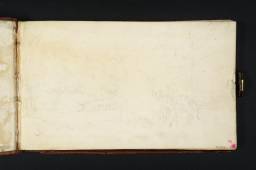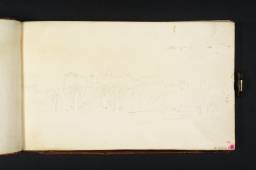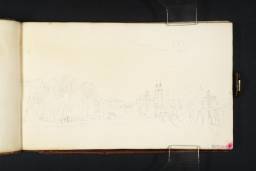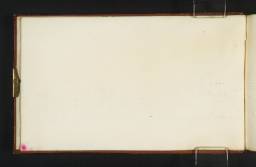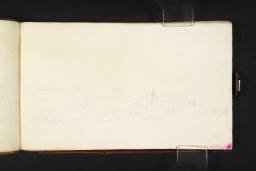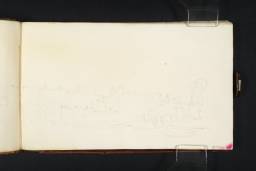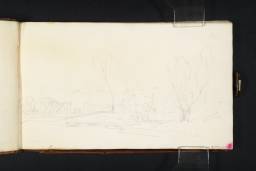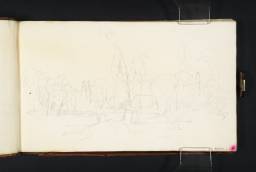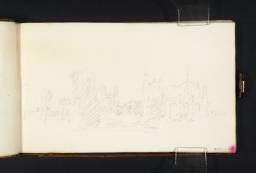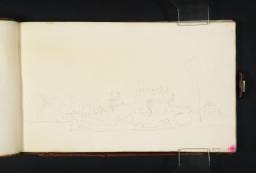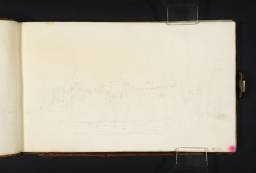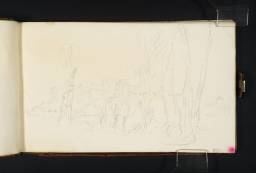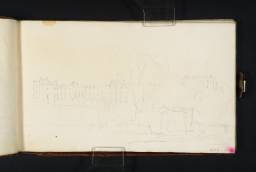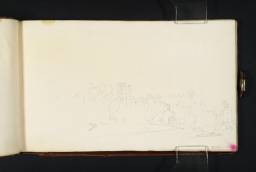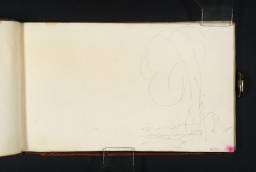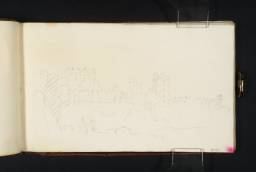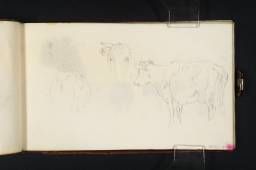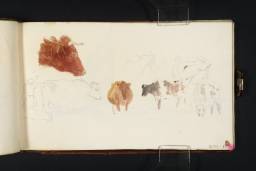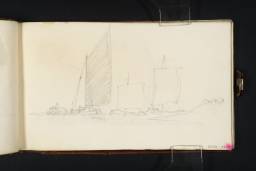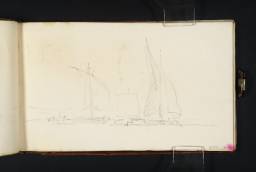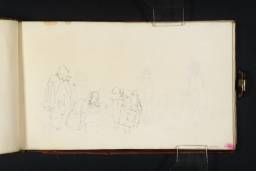Turner Bequest XCVII
Sketchbook, bound in calf, with brass clasp
91 leaves of white wove paper made on a double-faced mould
Approximate page size 107 x 182 mm
Made by ?William Balston and the brothers Finch and Thomas Robert Hollingworth at Turkey Mill, Maidstone, Kent, and watermarked ‘J WHA[TMAN] | 180...’
Inscribed by Turner in ink ‘46 Windsor Eaton’ on a label on the spine (D40655)
Endorsed by the Executors of the Turner Bequest in ink ‘No.335 Contains 48 sketches in Pencil | & Colour’ and signed by Charles Turner in ink ‘C. Turner’ and in pencil by Charles Lock Eastlake ‘C.L.E.’ and John Prescott Knight ‘J.P.K.’ inside front cover (D40656)
91 leaves of white wove paper made on a double-faced mould
Approximate page size 107 x 182 mm
Made by ?William Balston and the brothers Finch and Thomas Robert Hollingworth at Turkey Mill, Maidstone, Kent, and watermarked ‘J WHA[TMAN] | 180...’
Inscribed by Turner in ink ‘46 Windsor Eaton’ on a label on the spine (D40655)
Endorsed by the Executors of the Turner Bequest in ink ‘No.335 Contains 48 sketches in Pencil | & Colour’ and signed by Charles Turner in ink ‘C. Turner’ and in pencil by Charles Lock Eastlake ‘C.L.E.’ and John Prescott Knight ‘J.P.K.’ inside front cover (D40656)
Exhibition history
References
This sketchbook belongs to the group used on or near the Thames from circa 1805. It contains mainly slight pencil sketches of the river and of Windsor Castle, Eton College and probably Hammersmith; others of barges and sailing boats; and more of agricultural scenes, field workers, cattle and horses, several of these also touched with watercolour. It was dated by Finberg as probably 1807 and by John Gage to 1806. The earlier date for at least the first use of the book is confirmed by the presence of a draft of the verses written for The Goddess of Discord Choosing the Apple of Contention in the Garden of the Hesperides (Tate N00477)1 exhibited at the British Institition in 1806.
The book was not included by David Hill with those he associated with Turner’s residence at Sion (or Syon) Ferry House, Isleworth and dated to 1805.2 As Turner still kept the house during part of 1806, the Discord verses might argue for some use of the book there. On the other hand, as noted below, the completed version was not published when the picture was exhibited so the idea for an accompanying poem could be later anyway. The book was probably mainly used during Turner’s stays at 6 West End, Upper Mall, Hammersmith, his next riverside address from autumn 1806 until late in 1811. It has a close relationship to the River sketchbook (Tate D05961–D06071; D40650–D40654; Turner Bequest XCVI) whose themes it shares, as observed by Gerald Wilkinson.3 Both books contain sketches of sailing barges, other vessels and agricultural scenes, while the Hammersmith address is inscribed in the River book and views probably of the riverside at Hammersmith are on folios 58 and 60 of the present book (D06133, D06135). One of two houses marked by a cross on each of these might be Turner’s. However, this cannot be verified as the crosses seem to mark different houses in each view and the building itself no longer stands. Various views of Windsor might appear to overlap with those in the Wey, Guildford sketchbook datable to 1805 (Tate D06180–D06362; D40594–D40595; D41507; Turner Bequest XCVIII), and with related contemporary oil sketches, but the present book probably records later visits and subjects like folio 2 (D06073) and some of the sketches of field workers, ploughing and cattle can be associated with Ploughing up Turnips near Slough (Tate N00486)4 exhibited at Turner’s Gallery in 1809. As well as its distant view of Windsor Castle, this picture of a turnip harvest depicts current efforts to maximise yields and increase the food supply to serve the needs of a wartime economy. Similarly, the sketchbook shows the new, light-weight ploughs then coming into use and demonstrates Turner’s interest in agricultural improvements.
Two versions of the same passage of poetry are written on folios 83 and 83 verso (D06164, D06165), the second being longer. A similar ‘Ode to Discord’ in Turner’s Verse Book (private collection)5 must be intended as an epigraph for the 1806 Goddess of Discord although it was not published in the catalogue of the British Institution exhibition. The 1806 exhibition was the first at the Institution, which was founded in 1805 by patrons and collectors to ‘encourage and reward the talents of the Artists of the United Kingdom’. Interpretations of the picture usually hinge on its historical credentials as a fantasia on the origins of the Trojan War, its alchemical symbolism or a connection to the preoccupations of Turner’s Hammersmith neighbour, the painter Philippe Jacques de Loutherbourg, with science, chemistry and magic. However, the verses suggest that Turner might, at least privately, have toyed with a parallel satire as rivalry broke out between the Institution and the Royal Academy. Artists were wary of the Institution’s motives and leadership by self-appointed arbiters of taste. One of these, Sir George Beaumont, was a vociferous critic of Turner and the fire-breathing dragon in Turner’s 1806 picture, and described in his verses – ‘the Guardian Dragon in himself an host’ – prehaps represents Beaumont. (It might also be Mrs. Loutherbourg, who is said to have become so enraged by Turner’s constant visits and plunder of her husband’s professional secrets that she threw him out of the house). Another note inside the back cover of the book (D40658) is only partly legible, but seems to refer to the critical reception of art and artists ‘offering ... a new style’, and to recommend encouragement in ‘terms of cordiality’ rather than such as ‘convey doubt to the individual’.
Probably later additions to the sketchbook are two alternative recollections of the lake and temples at Stourhead, on folios 39 verso and 40 (D06111, D06112). Turner first visited Stourhead, the Wiltshire home or his early patron Sir Richard Colt Hoare, in 1795. The drawings here look more like composition studies than sketches from nature and folio 40 was probably an early idea for the watercolour Rise of the River Stour at Stourhead of circa 1817 (Sudeley Castle Trustees) exhibited at the Royal Academy in 1825.6 Turner is likely to have renewed contact with Hoare in 1808 while visiting North Wales and Tabley in Cheshire.7 Conceivably the watercolour was mooted then and variant compositions sketched from memory.
Technical notes
How to cite
David Blayney Brown, ‘Windsor and Eton sketchbook c.1806–8’, sketchbook, September 2008, in David Blayney Brown (ed.), J.M.W. Turner: Sketchbooks, Drawings and Watercolours, Tate Research Publication, December 2012, https://www


